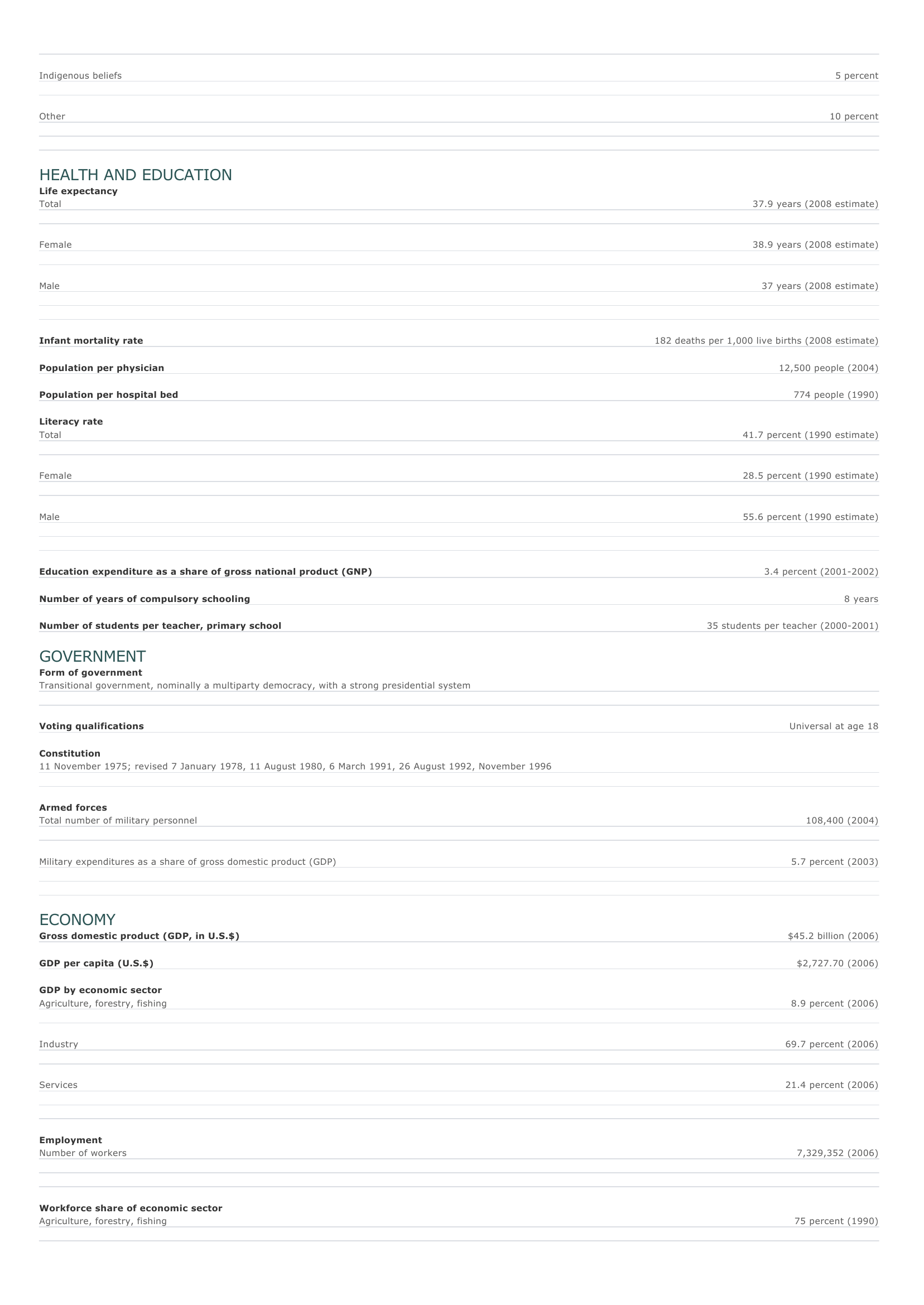
Angola Facts and Figures. BASIC FACTS Official name Capital Area Republic of Angola Luanda 1,246,700 sq km 481,350 sq mi PEOPLE Population 12,531,357 (2008 estimate) Population growth Population growth rate 2.14 percent (2008 estimate) Projected population in 2025 17,418,643 (2025 estimate) Projected population in 2050 24,746,652 (2050 estimate) Population density 10 persons per sq km (2008 estimate) 26 persons per sq mi (2008 estimate) Urban/rural distribution Share urban 37 percent (2005 estimate) Share rural 63 percent (2005 estimate) Largest cities, with population L uanda 2,623,000 (2003 estimate) Huambo 400,000 (1995 estimate) Benguela 155,000 (1983 estimate) Lobito 150,000 (1983 estimate) Ethnic groups Ovimbunda 37 percent Mbundu 25 percent Bakongo or Kongo 15 percent Lunda-Chokwe 8 percent Nganguela 6 percent European 1 percent O ther 8 percent Languages Portuguese (official); Bantu and other African languages Religious affiliations Roman Catholic 62 percent Protestant 15 percent Other Christians 8 percent Indigenous beliefs O ther 5 percent 10 percent HEALTH AND EDUCATION Life expectancy Total 37.9 years (2008 estimate) Female 38.9 years (2008 estimate) Male Infant mortality rate Population per physician Population per hospital bed 37 years (2008 estimate) 182 deaths per 1,000 live births (2008 estimate) 12,500 people (2004) 774 people (1990) Literacy rate Total 41.7 percent (1990 estimate) Female 28.5 percent (1990 estimate) Male 55.6 percent (1990 estimate) Education expenditure as a share of gross national product (GNP) Number of years of compulsory schooling Number of students per teacher, primary school 3.4 percent (2001-2002) 8 years 35 students per teacher (2000-2001) GOVERNMENT Form of government Transitional government, nominally a multiparty democracy, with a strong presidential system Voting qualifications Universal at age 18 Constitution 11 November 1975; revised 7 January 1978, 11 August 1980, 6 March 1991, 26 August 1992, November 1996 Armed forces Total number of military personnel Military expenditures as a share of gross domestic product (GDP) 108,400 (2004) 5.7 percent (2003) ECONOMY Gross domestic product (GDP, in U.S.$) GDP per capita (U.S.$) GDP by economic sector Agriculture, forestry, fishing $45.2 billion (2006) $2,727.70 (2006) 8.9 percent (2006) I ndustry 69.7 percent (2006) Services 21.4 percent (2006) Employment Number of workers 7,329,352 (2006) Workforce share of economic sector Agriculture, forestry, fishing 75 percent (1990) I ndustry 8 percent (1990) Services 17 percent (1990) Unemployment rate Not available National budget (U.S.$) Total revenue Not available Total expenditure Not available Monetary unit 1 readjusted kwanza (AOK), consisting of 100 lwei Major trade partners for exports United States, China, France, Taiwan, Belgium Major trade partners for imports Portugal, South Africa, United States, Brazil, France ENERGY, COMMUNICATIONS, AND TRANSPORTATION Electricity production Electricity from thermal sources 33.59 percent (2003 estimate) Electricity from hydroelectric sources 66.41 percent (2003 estimate) Electricity from nuclear sources 0 percent (2003 estimate) Electricity from geothermal, solar, and wind sources 0 percent (2003 estimate) Number of radios per 1,000 people 84 (2000 estimate) Number of telephones per 1,000 people 6 (2005) Number of televisions per 1,000 people 22 (2000 estimate) Number of Internet hosts per 10,000 people 0.01 (2003) Daily newspaper circulation per 1,000 people 12 (1996) Number of motor vehicles per 1,000 people 21 (1997) Paved road as a share of total roads 10 percent (2001) SOURCES Basic Facts and People sections Area data are from the statistical bureaus of individual countries. Population, population growth rate, and population projections are from the United States Census Bureau, International Programs Center, International Data Base (IDB) (www.census.gov). Urban and rural population data are from the Food and Agriculture Organization (FAO) of the United Nations (UN), FAOSTAT database (www.fao.org). Largest cities population data and political divisions data are from the statistical bureaus of individual countries. Ethnic divisions and religion data are largely from the latest Central Intelligence Agency (CIA) World Factbook and from various country censuses and reports. Language data are largely from the Ethnologue, Languages of the World, Summer Institute of Linguistics International (www.sil.org). Health and Education section Life expectancy and infant mortality data are from the United States Census Bureau, International Programs Center, International database (IDB) (www.census.gov). Population per physician and population per hospital bed data are from the World Health Organization (WHO) (www.who.int). Education data are from the United Nations Educational, Scientific and Cultural Organization (UNESCO) database (www.unesco.org). Government section Government, independence, legislature, constitution, highest court, and voting qualifications data are largely from various government Web sites, the latest Europa World Yearbook, and the latest Central Intelligence Agency (CIA) World Factbook. The armed forces data is from Military Balance. Economy section Gross domestic product (GDP), GDP per capita, GDP by economic sectors, employment, and national budget data are from the World Bank database (www.worldbank.org). Monetary unit, agriculture, mining, manufacturing, exports, imports, and major trade partner information is from the statistical bureaus of individual countries, latest Europa World Yearbook, and various United Nations and International Monetary Fund (IMF) publications. Energy, Communication, and Transportation section Electricity information is from the Energy Information Administration (EIA) database (www.eia.doe.gov). Radio, telephone, television, and newspaper information is from the United Nations Educational, Scientific and Cultural Organization (UNESCO) database (www.unesco.org). Internet hosts, motor vehicles, and road data are from the World Bank database (www.worldbank.org). Note Figures may not total 100 percent due to rounding. Microsoft ® Encarta ® 2009. © 1993-2008 Microsoft Corporation. All rights reserved.





